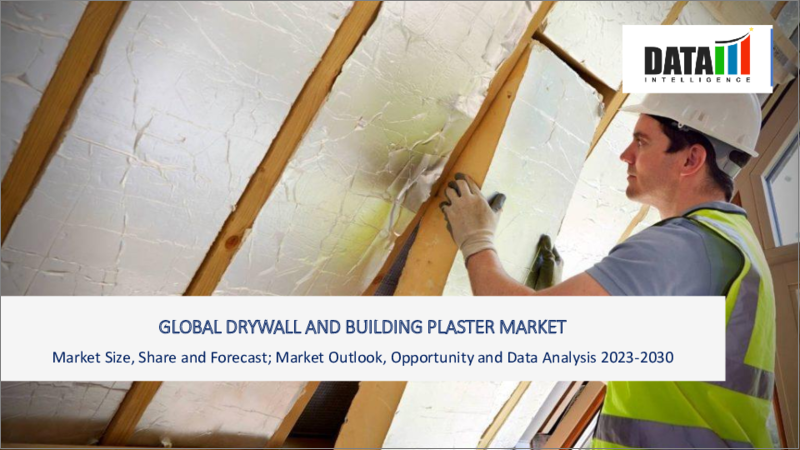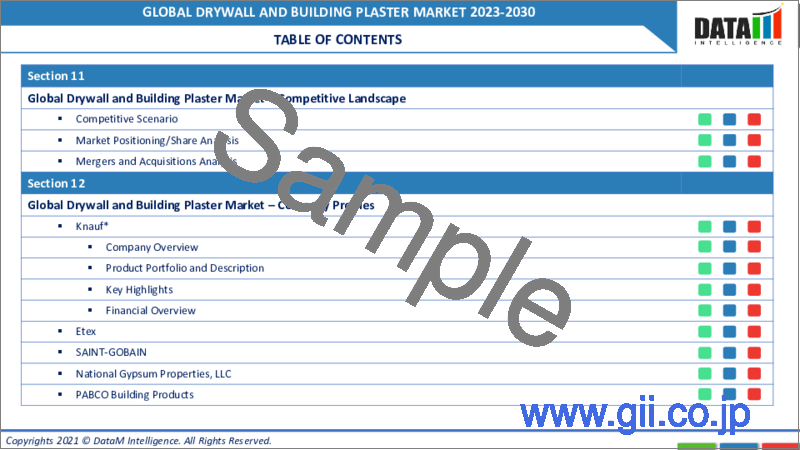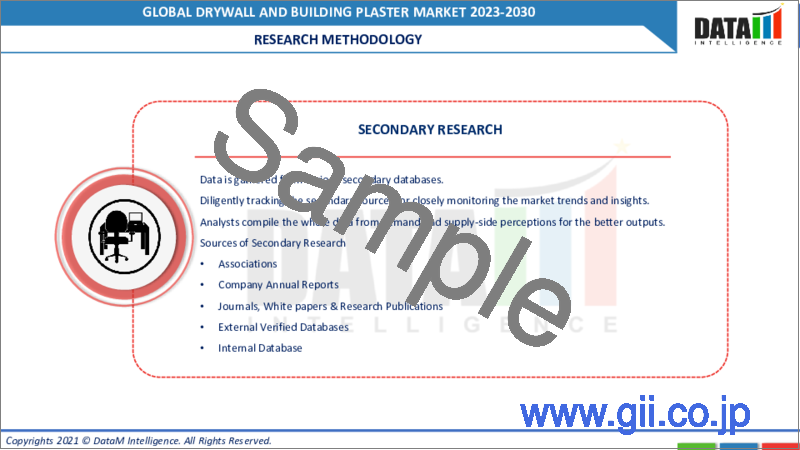|
|
市場調査レポート
商品コード
1217568
乾式壁と建築用プラスターの世界市場-2023-2030Global Drywall and Building Plaster Market - 2023-2030 |
||||||
|
● お客様のご希望に応じて、既存データの加工や未掲載情報(例:国別セグメント)の追加などの対応が可能です。 詳細はお問い合わせください。 |
|||||||
| 乾式壁と建築用プラスターの世界市場-2023-2030 |
|
出版日: 2023年02月14日
発行: DataM Intelligence
ページ情報: 英文 212 Pages
納期: 約2営業日
|
- 全表示
- 概要
- 目次
市場概要
乾式壁とは、石膏を厚紙で挟んでプレスしたパネルを指し、天井や壁を作るために使用されます。乾式壁は、従来の石膏に代わるよりスピーディーな施工が可能な工法として登場しました。建設活動の世界の急速な拡大は、世界の乾式壁と建築用プラスター市場を推進しています。乾式壁による建設技術の革新により、各国の建設会社の数は増加すると予測されています。その結果、乾式壁と乾式壁と建築用プラスター市場を押し上げると予想されます。
市場力学
建設活動の急速な拡大は、主に世界の乾式壁および建築用プラスター市場を牽引しています。これは、乾式壁と建築用プラスター市場を大幅に押し上げると思われます。しかし、環境パラメータに対する耐性の欠如、高価格、代替品の入手可能性が、乾式壁および建築用プラスター市場の成長を制限しています。
建設部門における乾式壁および建築用プラスターの需要の増加
市場の成長は、世界レベルで住宅、商業、工業、その他の用途で所有する乾式壁&建築用プラスターの需要増に起因することができます。乾式壁は、軽量の建設材料として、ショッピングコンプレックスやホテルの特定の建設要件を遵守し、耐火性であることが判明しています。防音設備を求めるホテル、レストラン、教育機関は、乾式壁と建築用プラスターの市場に注目しています。乾式壁は、住宅の美観を向上させるとともに、偽天井による断熱効果で室内の熱を管理する上で欠かせないです。
また、空間を仕切ったり、作ったりすることができるため、インテリアのカスタマイズを素早く、スムーズに行うことができると人気が高まっています。したがって、乾式壁&建築用プラスターの市場規模は、予測期間中に収益と指数関数的な市場成長を開発することが期待されます。
環境パラメータへの耐性の欠如、高い価格と代替品の可用性は、乾式壁&ビルディングプラスター市場の成長を制限する
乾式壁は適度にデリケートであり、破損のリスクを負います。さらに、乾式壁は設置に熟練した人手を必要とし、固定費を増加させます。さらに、乾式壁土の研磨は細かい粉塵が発生するため、好ましくない手順であることも指摘されています。また、湿気は真菌の繁殖を招き、健康被害をもたらすこともあります。
ワフウォールなどの代替品はより有益であり、ますます求められています。それは、インストールが容易で、初期コストを削減し、また、特定の材料の厚さのため、より大きな耐熱性を持っています。さらに、テクスチャーウォールパネルは、乾式壁よりも美観に優れているため、既存の壁の上に簡単に取り付けることができます。リアルウッドパネルも乾式壁より外観が良く、付属品で簡単に取り付けられます。
COVID-19の影響分析
COVID-19の流行は、世界の乾式壁と建築用プラスターの市場に大きな影響を与えました。貿易制限、サプライチェーンの寸断、政府による製品製造の制限、世界のロックダウンがそれぞれの市場に影響を与えました。そのため、建材加工工場は閉鎖されました。世界の乾式壁材および建築用プラスター市場の需要は、国際的に減少しました。
さらに、政府による移動規制や施錠により、新製品の開発は大幅に遅れました。また、企業がサプライチェーンに対応することが難しくなりました。
それにもかかわらず、パンデミックは、世界の乾式壁と建物の石膏市場の長期的な成長見通しに影響を与えることができなかったとして、乾式壁と建物の石膏市場に全体的な影響は最小限でした。したがって、乾式壁と建築用しっくいの需要は依然として強く、今後数年間は徐々に成長すると予想されます。
目次
第1章 世界の乾式壁と建築用プラスターの市場調査手法と範囲
- 調査手法
- 調査目的および調査範囲
第2章 乾式壁と建築用プラスターの世界市場-市場の定義と概要
第3章 乾式壁と建築用プラスターの世界市場- エグゼクティブサマリー
- 製品別市場内訳
- 流通チャネル別市場内訳
- エンドユーザー別市場内訳
- 地域別市場内訳
第4章 乾式壁と建築用プラスターの世界市場-市場力学
- 市場影響要因
- 促進要因
- 建築分野での乾式壁と建築用プラスターの需要増加
- 抑制要因
- 乾式壁と建築用プラスターの市場を抑制するための補助的なコンポーネントが利用されている
- 機会
- 促進要因
第5章 乾式壁と建築用プラスターの世界市場-用途分析
- ポーターのファイブフォース分析
- サプライチェーン分析
- 価格設定分析
- 規制分析
第6章 乾式壁と建築用プラスターの世界市場-COVID-19分析
- COVID-19の市場分析
- COVID-19の市場シナリオの前
- COVID-19の現在の市場シナリオ
- COVID-19の後、または将来のシナリオ
- COVID-19の中での価格ダイナミクス
- 需給バランス
- パンデミック時の市場に関連する政府の取り組み
- メーカーの戦略的取り組み
- まとめ
第7章 乾式壁と建築用プラスターの世界市場- 製品別
- 耐火性
- 耐水性
- 石膏ボード
- ウォールボード
- その他
第8章 乾式壁と建築用プラスターの世界市場- 流通チャネル別
- 小売
- 卸売
- オンライン
第9章 乾式壁と建築用プラスターの世界市場-エンドユーザー別
- 住宅用
- 商業用
- 工業用
- その他
第10章 乾式壁と建築用プラスターの世界市場-地域別
- アジア太平洋地域
- 中国
- インド
- 韓国
- 日本
- その他アジア太平洋地域
- 北米
- 米国
- カナダ
- メキシコ
- 欧州
- 英国
- ドイツ
- フランス
- イタリア
- スペイン
- その他の南米地域
- 南米
- ブラジル
- アルゼンチン
- チリ
- その他の南米地域
- 中東とアフリカ
第11章 乾式壁と建築用プラスターの世界市場- 競争情勢
- 競合シナリオ
- 市況分析/シェア分析
- 合併・買収の分析
第12章 乾式壁と建築用プラスターの世界市場企業プロファイル
- Saint-Gobain
- 企業概要
- アプリケーションのポートフォリオと説明
- 主なハイライト
- 財務概要
- Knauf Gips
- Fermacell
- Georgia-Pacific
- PABCO Building Products
- Winstone Wallboards
- China National Building Material.
- Yoshino Gypsum
- Lime Green Products
- Supress Products
第13章 乾式壁と建築用プラスターの世界市場-重要考察
第14章 乾式壁と建築用プラスターの世界市場-DataM
Market Overview
The global drywall and building plaster market size was worth US$ XX million in 2022 and is estimated to reach US$ XX million by 2030, growing at a CAGR of XX% during the forecast period (2023-2030).
Drywall refers to panels made from gypsum plaster pressed between thick sheets of paper and it is used to make ceilings or walls. Drywall construction has emerged as a speedier alternative to traditional plaster. The rapid expansion of construction activities globally propels the global drywall and building plaster market. The number of construction firms across countries is projected to increase with the innovation of drywall-based construction techniques. It is, in turn, expected to boost the market for drywall and building plasters.
Market Dynamics
The rapid expansion of construction activities globally principally drives the global drywall and building plaster market. It is likely to boost the market for drywall and building plasters significantly. However, The lack of resistance to environmental parameters, high price and availability of substitutes restricts the growth of the drywall & building plaster market.
Increasing demand for drywall & building plaster in construction sectors
The market's growth can be attributed to the increasing demand for drywall & building plaster owned for residential, commercial, industrial and others applications across the global level. Drywall has been found to adhere to specific construction requirements in shopping complexes and hotels as a lightweight construction material and is fire-resistant. The hotels, restaurants and educational institutes seeking soundproof facilities have looked to the drywall and building plaster market. Drywalls are essential in improving the aesthetic appeal of residential properties while also managing interior heat through thermal insulation provided by false ceilings.
Drywalls have also grown in popularity due to their versatility in dividing and creating spaces, allowing for quick and seamless interior customization options. Therefore, the drywall & building plaster market size is expected to develop revenue and exponential market growth during the forecast period.
The lack of resistance to environmental parameters, high price and availability of substitutes restricts the growth of the drywall & building plaster market
The drywall is moderately delicate and bears a risk of being damaged. In addition, drywall requires skilled manpower for installation, increasing the fixed cost. Couple this with the point that drywall mud sanding is an unwanted procedural step because of the fine dust created. Humidity can impact drywalls mainly by creating fungi growth, which can be a health hazard.
The alternatives, such as wahoo walls, are more beneficial and increasingly sought out. It is easy to install, reducing the initial cost and also has greater heat resistance because of a particular material thickness. Additionally, textured wall panels can be easily fitted over existing walls as they are aesthetically superior to drywalls. Real wood veneer paneling also looks better appearance-wise than drywall and the accessories available permit easy installation of the former.
COVID-19 impact analysis
The COVID-19 pandemic unevenly impacted the global drywall and building plaster market. Trade restrictions, breaking supply chains, government restrictions on manufacturing products and globally lockdowns affected the respective market. Therefore, the construction materials processing factories were closed. The demand for the global drywall and building plaster market decreased internationally.
Further, with the government movement restrictions and lockdowns, the development of new products was slowed considerably. It also hampered the ability of companies to respond to supply chains giving much more challenging.
Nonetheless, the overall impact of the pandemic has been minimal on the drywall and building plaster market as the pandemic failed to impact the long-term growth prospects of the global drywall and building plaster market. Thus, the demand for drywall and building plaster remains strong and is expected to grow gradually in the coming years.
Segment Analysis
The global drywall and building plaster market are segmented into product, distribution channel, end-user and region.
The residential segment covered a large area of the drywall and building plaster market due to a focus on energy-efficiency properties
The drywall and building plaster market is further subdivided by end-user into residential, commercial, industrial and others. The expansion of new home development and renovation caused the need for drywall and plaster in the residential building to increase. While drywall is a good insulator and can lower energy expenditures in a home, building plaster can make airtight seals around windows and doors, increasing a home's energy efficiency. Therefore, the growing emphasis on energy efficiency is another factor driving the need for drywall and construction plaster in residential construction.
Geographical Analysis
The global drywall and building plaster market are segmented into product, distribution channel, end-user and region.
Effective growth in investments in residential and construction industries in Asia-Pacific leads to propels the drywall and building plaster market in the region
Asia-Pacific has a leading regional share in the global drywall and building plaster market. Asia-Pacific is predicted to control the largest share of the global drywall and building plaster market during the forecast due to growth in the consumption and production of plaster in China. However, speedily expanding economies such as India, Indonesia and Malaysia also propose lucrative opportunities for the market. The effective growth in investments in residential and construction industries owing to increased purchasing power propels the global drywall and building plaster market. The rising population will affect the production capacity and provide the demand for energy-efficient drywall and building plaster industry.
Competitive Landscape
The building plaster market is competitive due to the availability of a wide range of medical foam that caters to different end-use applications. The major players contributing to growth in the market are Saint-Gobain, SANKO, Knauf Gips, Fermacell, Georgia-Pacific, PABCO Building Products Winstone Wallboards, China National Building Material, Yoshino Gypsum and Lime Green Products. The major players in the market adopt several growth strategies such as formulating and patenting new molecules, researching new sources, collaborations and joint ventures to contribute to growth in the industry.
Saint-Gobain
Overview: Saint-Gobain is a multinational company specializing in developing and manufacturing light and sustainable construction. Saint-Gobain develops, designs, manufactures and distributes materials and services for the construction and industrial markets. The company primarily develops formulations for thermal insulation, materials, industrial solutions, surface technologies, nutrition and care. Saint-Gobain founded in 1665 by De Saint-Gobain S.A. Saint-Gobain is headquartered in Courbevoie, France. Saint-Gobain develops, produces and markets intermediates globally. The most important of the division's product groups include construction, building and distribution, mobility and industry.
Product Portfolio
- Gyproc Drywall Systems A self-drilling drywall screw is used to install gypsum plasterboards on either side of a GI steel frame to create a high-performance, lightweight internal wall system. Compared to other traditional approaches like brick/block, it consumes less time, is simpler to install and requires less manpower. Gyproc Drywalls offer high fire resistance and good sound insulation. Furthermore, because drywall is significantly lighter than traditional brick/block structures, there are significant structural cost advantages. With the help of its centralized design team, Gyproc India has solid technical capabilities that can support you with drywall solutions that are both cost- and performance-efficient.
Key Developments:
- In March 2021, Saint-Gobain announced its investment in a 60/40 joint venture company with InDeco, one of the highest decoration and design companies for public space in China, to strengthen their long-term partnership in the field of modular construction, one step further in the Group strategy of the sustainable construction industry.
Why Purchase the Report?
- Visualize the composition of the global drywall and building plaster market segmentation by product, distribution channel, end-user and region, highlighting the critical commercial assets and players.
- Identify commercial opportunities in the global drywall and building plaster market by analyzing trends and co-development deals.
- Excel data sheet with thousands of global drywall and building plaster market-level 4/5 segmentation data points.
- PDF report with the most relevant analysis cogently put together after exhaustive qualitative interviews and in-depth market study.
- Product mapping in excel for the critical product of all major market players
The global drywall and building plaster market report would provide approximately 61 market data tables, 60 figures and 212 pages.
Target Audience 2022
- Fire-resistant manufacturers
- Water-resistant manufacture
- Plasterboard transportation
- Wallboard manufacturers
- Chemical companies manufacturers
- Education & Research Institutes
- Research Professionals
Table of Contents
1. Global Drywall and Building Plaster Market Methodology and Scope
- 1.1. Research Methodology
- 1.2. Research Objective and Scope of the Report
2. Global Drywall and Building Plaster Market - Market Definition and Overview
3. Global Drywall and Building Plaster Market - Executive Summary
- 3.1. Market Snippet by Product
- 3.2. Market Snippet by Distribution Channel
- 3.3. Market Snippet by End-User
- 3.4. Market Snippet by Region
4. Global Drywall and Building Plaster Market -Market Dynamics
- 4.1. Market Impacting Factors
- 4.1.1. Drivers
- 4.1.1.1. Increasing demand for drywall & building plaster in construction sectors
- 4.1.1.2. XX
- 4.1.2. Restraints
- 4.1.2.1. The subsisted components are availed to restrain the drywall & building plaster market
- 4.1.2.2. XX
- 4.1.3. Opportunity
- 4.1.3.1. XX
- 4.1.1. Drivers
5. Global Drywall and Building Plaster Market - Application Analysis
- 5.1. Porter's Five Forces Analysis
- 5.2. Supply Chain Analysis
- 5.3. Pricing Analysis
- 5.4. Regulatory Analysis
6. Global Drywall and Building Plaster Market - COVID-19 Analysis
- 6.1. Analysis of COVID-19 on the Market
- 6.1.1. Before the COVID-19 Market Scenario
- 6.1.2. Present COVID-19 Market Scenario
- 6.1.3. After COVID-19 or a Future Scenario
- 6.2. Pricing Dynamics Amid COVID-19
- 6.3. Demand-Supply Spectrum
- 6.4. Government Initiatives Related to the Market During the Pandemic
- 6.5. Manufacturers Strategic Initiatives
- 6.6. Conclusion
7. Global Drywall and Building Plaster Market - By Product
- 7.1. Introduction
- 7.1.1. Market Size Analysis and Y-o-Y Growth Analysis (%), By Product
- 7.1.2. Market Attractiveness Index, By Product
- 7.2. Fire-resistant
- 7.2.1. Introduction
- 7.2.2. Market Size Analysis and Y-o-Y Growth Analysis (%)
- 7.3. Water-resistant
- 7.4. Plasterboard
- 7.5. Wallboard
- 7.6. Others
8. Global Drywall and Building Plaster Market - By Distribution Channel
- 8.1. Introduction
- 8.1.1. Market Size Analysis and Y-o-Y Growth Analysis (%), By Distribution Channel
- 8.1.2. Market Attractiveness Index, By Distribution Channel
- 8.2. Retail
- 8.2.1. Introduction
- 8.2.2. Market Size Analysis and Y-o-Y Growth Analysis (%)
- 8.3. Wholesale
- 8.4. Online
9. Global Drywall and Building Plaster Market - By End-User
- 9.1. Introduction
- 9.1.1. Market Size Analysis and Y-o-Y Growth Analysis (%), By End-User
- 9.1.2. Market Attractiveness Index, By End-User
- 9.2. Residential
- 9.2.1. Introduction
- 9.2.2. Market Size Analysis and Y-o-Y Growth Analysis (%)
- 9.3. Commercial
- 9.4. Industrial
- 9.5. Others
10. Global Drywall and Building Plaster Market - By Region
- 10.1. Introduction
- 10.1.1. Market Size Analysis and Y-o-Y Growth Analysis (%), By Region
- 10.1.2. Market Attractiveness Index, By Region
- 10.2. Asia-Pacific
- 10.2.1. Introduction
- 10.2.2. Key Region-Specific Dynamics
- 10.2.3. Market Size Analysis and Y-o-Y Growth Analysis (%), By Product
- 10.2.4. Market Size Analysis and Y-o-Y Growth Analysis (%), By Distribution Channel
- 10.2.5. Market Size Analysis and Y-o-Y Growth Analysis (%), By End-User
- 10.2.6. Market Size Analysis and Y-o-Y Growth Analysis (%), By Country
- 10.2.6.1. China
- 10.2.6.2. India
- 10.2.6.3. South Korea
- 10.2.6.4. Japan
- 10.2.6.5. Rest of Asia-Pacific
- 10.3. North America
- 10.3.1. Introduction
- 10.3.2. Key Region-Specific Dynamics
- 10.3.3. Market Size Analysis and Y-o-Y Growth Analysis (%), By Product
- 10.3.4. Market Size Analysis and Y-o-Y Growth Analysis (%), By Distribution Channel
- 10.3.5. Market Size Analysis and Y-o-Y Growth Analysis (%), By End-User
- 10.3.6. Market Size Analysis and Y-o-Y Growth Analysis (%), By Country
- 10.3.6.1. U.S.
- 10.3.6.2. Canada
- 10.3.6.3. Mexico
- 10.4. Europe
- 10.4.1. Introduction
- 10.4.2. Key Region-Specific Dynamics
- 10.4.3. Market Size Analysis and Y-o-Y Growth Analysis (%), By Product
- 10.4.4. Market Size Analysis and Y-o-Y Growth Analysis (%), By Distribution Channel
- 10.4.5. Market Size Analysis and Y-o-Y Growth Analysis (%), By End-User
- 10.4.6. Market Size Analysis and Y-o-Y Growth Analysis (%), By Country
- 10.4.6.1. UK
- 10.4.6.2. Germany
- 10.4.6.3. France
- 10.4.6.4. Italy
- 10.4.6.5. Spain
- 10.4.6.6. Rest of South America
- 10.5. South America
- 10.5.1. Introduction
- 10.5.2. Key Region-Specific Dynamics
- 10.5.3. Market Size Analysis and Y-o-Y Growth Analysis (%), By Product
- 10.5.4. Market Size Analysis and Y-o-Y Growth Analysis (%), By Distribution Channel
- 10.5.5. Market Size Analysis and Y-o-Y Growth Analysis (%), By End-User
- 10.5.6. Market Size Analysis and Y-o-Y Growth Analysis (%), By Country
- 10.5.6.1. Brazil
- 10.5.6.2. Argentina
- 10.5.6.3. Chile
- 10.5.6.4. Rest of South America
- 10.6. Middle East and Africa
- 10.6.1. Introduction
- 10.6.2. Key Region-Specific Dynamics
- 10.6.3. Market Size Analysis and Y-o-Y Growth Analysis (%), By Product
- 10.6.4. Market Size Analysis and Y-o-Y Growth Analysis (%), By Distribution Channel
- 10.6.5. Market Size Analysis and Y-o-Y Growth Analysis (%), By End-User
11. Global Drywall and Building Plaster Market - Competitive Landscape
- 11.1. Competitive Scenario
- 11.2. Market Positioning/Share Analysis
- 11.3. Mergers and Acquisitions Analysis
12. Global Drywall and Building Plaster Market Company Profiles
- 12.1. Saint-Gobain
- 12.1.1. Company Overview
- 12.1.2. Application Portfolio and Description
- 12.1.3. Key Highlights
- 12.1.4. Financial Overview
- 12.2. Knauf Gips
- 12.3. Fermacell
- 12.4. Georgia-Pacific
- 12.5. PABCO Building Products
- 12.6. Winstone Wallboards
- 12.7. China National Building Material.
- 12.8. Yoshino Gypsum
- 12.9. Lime Green Products
- 12.10. Supress Products
LIST NOT EXHAUSTIVE
13. Global Drywall and Building Plaster Market- Premium Insights
14. Global Drywall and Building Plaster Market- DataM
- 14.1. Appendix
- 14.2. About Us and Services
- 14.3. Contact Us




